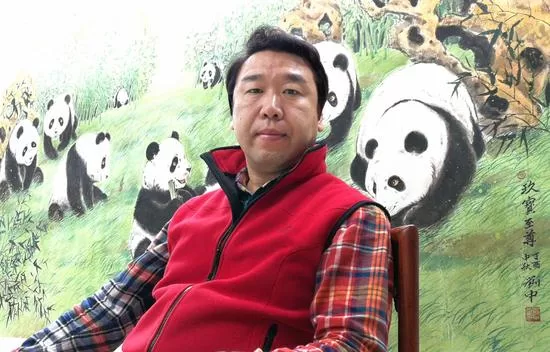
BEIJING, April 19 (WSH) — In the landscape of contemporary Chinese painting, one artist has captured the soul of a nation through the image of a single creature. That artist is Liu Zhong, widely celebrated as “China’s leading panda painter.” His work transcends simple depictions of animals; it is a vibrant, visual narrative of Chinese spirit, wisdom, and identity.

Liu’s pandas are not zoo caricatures. With masterful control of ink and brush, he captures their round, amiable figures and infuses them with emotion and personality. More than just adorable faces, his pandas are symbolic figures—gentle emissaries of Chinese culture. Each painting, in black and white, is a dialogue of yin and yang, stillness and movement, simplicity and depth.
Pandas as National Symbols, Carriers of Culture

Pandas have long been seen as symbols of peace and harmony in China. Their temperament and aesthetic simplicity echo traditional Chinese values of balance and coexistence. Liu Zhong fully embraces this symbolism, turning the panda into a visual metaphor for the essence of Chinese civilization.
In his paintings, pandas sit peacefully, gaze thoughtfully into the distance, or frolic with bamboo, exuding both innocence and insight. Their presence is not only charming but meaningful—a mirror reflecting the quiet strength and deep-rooted wisdom of the Chinese people.

From Ink to Meaning: Aesthetics of the East
Liu’s technique is rooted in traditional Chinese ink painting but breathes with contemporary sensibilities. Through subtle washes and bold contrasts, his brushstrokes create not only form but atmosphere. Most striking is his attention to the pandas’ eyes—windows into their inner world, conveying joy, reflection, and serenity.
These artistic choices are not just technical; they are philosophical. In Liu’s work, the panda becomes a vehicle for expressing “the three beauties”: static beauty like the harmony of a Taiji diagram; dynamic beauty like the unrestrained flow of cursive calligraphy; and emotional beauty, embodying the Daoist ideal of unity between man and nature.

Harmony, Balance, and a Shared World
Black and white fur becomes more than color—it becomes concept. Liu’s panda art communicates the Chinese idea of “he,” or harmony: a peaceful relationship between individuals, communities, and nature. His use of blank space invites the viewer to breathe, to reflect, to engage with the artwork beyond what is seen.
His pandas are often set amidst bamboo forests, misty mountains, or flowing water—scenes that represent not just nature but ecological consciousness. These compositions echo modern China’s call for “lucid waters and lush mountains,” an eco-civilization where beauty and sustainability coexist.

A Global Voice for Chinese Art
Liu Zhong’s works are more than local treasures. They have been exhibited and collected around the world, becoming quiet ambassadors for Chinese values and aesthetics. In an age of globalization, his art offers a unique voice—a way for the world to see not only how China looks, but how China feels.
He paints not just cute animals, but profound cultural allegories. His pandas tell stories of kindness, resilience, harmony, and inner strength—universal values rendered through an Eastern lens.

Conclusion: Painting the Spirit of a Civilization
As the old saying goes, “Painting the spirit is the hardest part.” Liu Zhong has done just that. With ink and intuition, he has given form to a nation’s soul. His pandas are more than symbols; they are reflections of cultural confidence, expressions of timeless wisdom.
To stand before his paintings is to glimpse the essence of China—not just its heritage, but its hope. In the tranquil gaze of a panda, we find a world where tradition and modernity, nature and humanity, art and meaning gently embrace.
This is the true power of Liu Zhong’s art: it moves not only the eye, but the heart.



sg57oe